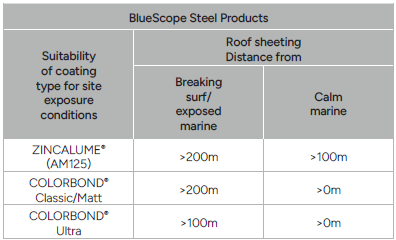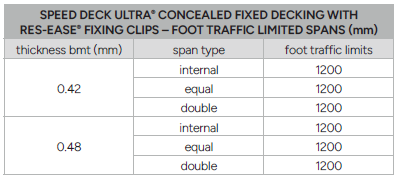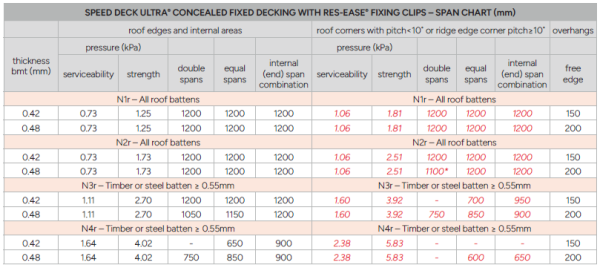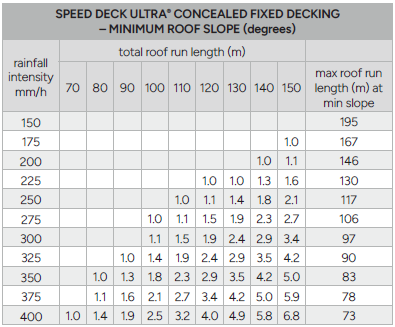- Greatly reduced noise from thermal expansion and contraction in concealed fixed decking gives peace of mind for owners and installers
- Easier to install with quick clipping arrangement
- Clip is made from engineering-grade polymer,
eliminating risk of clip corrosion - Centralised fastening points for better strength
- Independently tested for up to BAL 12.5 Rated areas
- Achieved N4r Wind Rating making it suitable for large proportion of residential buildings
- Automatic Bird Proofing as a built in accessory with no need for extra components
- Ideal for low slope roofs as low as 1°
- Proudly Australian Made
Note: Throughout this product page, when the reader sees the term “the system”, this is referring to the “RES-EASE® Fixing Clips used in conjunction with Speed Deck Ultra® Concealed Fixed Decking.
Where to Buy
The RES-EASE® System Solution is currently available to residential direct Stramit account customers and can be purchased from Stramit branches. Please note, Stramit does not sell direct to the public.
Availability
The RES-EASE® System Solution is available to residential direct Stramit account customers nationally. Please check with our friendly team to confirm if the RES-EASE® System Solution is suitable for your next project.
News and Case Studies
General Information
Speed Deck Ultra® Concealed Fixed Decking, with RES-EASE® Fixing Clips, will be very durable in most locations, subject to corrosion categories. It is however important to choose the correct coating for each application environment. The table below shows the suitability of materials and coating types for different exposure conditions, provided there is no other aggressive influence which could affect the durability.

The suitability and exposure tables above and below are current at the time of publication and are guidelines only; conditions will vary from site
to site. For BlueScope products, please check the BlueScope Technical Bulletins at www.bluescopesteel.com.au for the latest information and guidance on selection, maintenance and durability. If uncertain about the appropriate coating for a particular application, or if the product is to be used in environments affected by industrial emissions, fossil fuel combustion, animal farming, or has unwashed areas, please contact Stramit for advice.

For UniCote® Select and UniCote® Coastal products, please refer to the latest versions of their respective datasheets, available on the UniCote® website at www.unicote.com.au.
The system consisting of Speed Deck Ultra® Concealed Fixed Decking and RES-EASE® Fixing Clips was tested and passed a BAL 12.5 bushfire rating. The testing was carried out at Warringtonfire laboratory in Melbourne. For further details contact Stramit.
All building products need to be checked for compatibility with adjacent materials. These checks need to be for both direct contact between materials, and where water runs from one material to another.
The following guidelines generally avoid material incompatibility:
- For zinc-aluminium alloy coated steel, colour coated steel and galvanised steel cladding avoid copper, lead, green or treated timber, stainless steel and mortar or concrete.
- Galvanised steel sheets should not receive drainage from aluminium or any inert materials, such as plastics, glass, glazed tiles, colour coated and zinc-aluminium alloy.
Stramit's roofing and walling products should be handled with care at all times to preserve the product capabilities and quality of the finish.
Packs should always be kept dry and stored above ground level while on site. If the products become wet, they should be separated, wiped and placed in the open to promote drying.
Speed Deck Ultra® Concealed Fixed Decking is supplied cut-to-length. When designing or transporting long products ensure that the length is within the limit of local Transport Authority regulations. The manufacturing tolerance on the length of product supplied is +0,-15mm.
Stramit products conform to the following Australian standards that are called up in the NCC.
Steel material
- All metallic coated steel complies with AS 1397
- Painted steel product conforms with AS 2728
Roofing / Walling products
- Roofing/walling profiles conform with AS 1562.1, and AS 4040 parts 0, 1, 2 and 3.
- Corrugated roofing conforms with AS 1445
- Wind Load data conforms to AS 1170 part 2, and/or AS 4055
- Fasteners conform with AS 3566
- Installation details are in accordance with the Standards Australia Handbook HB39
Noise, including thermally-induced noise, in metal roofing can result from many factors or a mix of factors. Thermally-induced noise is caused by movement at fasteners and connections where the roof sheeting expands relative to its supports or clips.
This movement is resisted by the friction between the sheeting and its supports or clips.
By using RES-EASE® Fixing Clips, in conjunction with Speed Deck Ultra® Concealed Fixed Decking, this noise is reduced, as the nylon material allows the sheeting to slip purposefully on the clip and not constrain it, unlike the steel clip. This will allow gradual movement of the sheeting instead of spurts of movement, resulting in minimal noise.
It is common for all types of steel roofs to have a low level of noise such as crackling or clicking, even when fixed with a screw through the crest of the sheeting. Other factors that could result in metal roofing noise are rain, wind, weather extremes such as hail, thunder, structural movements resulting from lack of rigidity, structural settlement, shrinkage, ground movements or excavations, number of additions fixed to the roof (e.g. solar panels) etc. The type of noise, frequency, patterns, volume, duration and regularity can be quite variable.
For Speed Deck Ultra® Concealed Fixed Decking, with RES-EASE® Fixing Clips, noise can be reduced (but not necessarily removed altogether) by a range of methods. As a guide some general methods include:
- Using light coloured sheeting instead of darker colours
which retain more heat. - Steel supports are better than timber supports.
- Adding insulation in the roof space to reduce temperature
difference. Where the blanket is tight against the sheeting
underside it will have a better effect on noise reduction.
Where ceiling insulation is provided in tropical areas, having
the silver foil facing upwards. - Venting the roof area.
- Adding an expansion joint to reduce movement. This is
especially important where long sheets are used. Details
around valleys must be carefully considered as heat could
be retained. - Including a material between the sheeting and supports
to allow easier movement, for example PVC tape or foil
laminate strips. - Structure of the roof must be well braced and rigid enough
to ensure movement due to wind effects, thermal actions
and vibrations are minimised.
Stramit's roofing and walling products are protected in Australia by registered designs.
All Stramit roofing and wall cladding products conform with, or are equivalent to, AS1562.1.
Stramit has in-house, purpose built testing equipment used to design, develop and improve products for the Australian market. Many of our products are tested or witnessed by independent organisations. These include:
- University of Technology, Sydney
- Cyclone Testing Station (James Cook University)
- The University of Sydney, and
- CSIRO.
The ongoing research and development activity ensure we remain at the forefront of innovation, design and consumer information.
Technical Information
Please refer to the Stramit Roof and Wall Flashing Architectural Detailing Design Guide.
The roofing/walling to be 0.42 (or 0.48) mm BMT Speed Deck Ultra® Concealed Fixed Decking in continuous lengths with trapezoidal ribs 43mm high, spaced at 233mm centres, fixed with RES-EASE® Fixing Clips. Sheeting materials to be protected steel sheet to Australian Standard AS 1397, with a minimum yield stress of 550MPa (Grade G550) and an AM100/AZ150 coating with an oven-baked paint film of selected colour, or a plain AM125/AZ150
coating. The sheeting must be fixed to the battens in accordance with the manufacturer’s instructions using patented RES-EASE® Fixing Clips supplied.
Clips must be fastened to battens with screws supplied in accordance with Australian Standard AS 3566, suitable for minimum corrosivity category 3, and attached under every rib. Sheets must be laid in such a manner that the approved side lap faces away from prevailing weather. A minimum of 50mm must
be provided for projection into eave gutters. Flashings must be provided in compatible materials as specified; minimum cover of flashings must be 150mm.
All sheeting must be fixed in a workman-like manner, leaving the job clean and weathertight. All debris (nuts, screws, cuttings, filings etc.) must be cleaned off daily.
The Speed Deck Ultra® Concealed Fixed Decking with RES-EASE® Fixing Clips is currently not suitable for cyclonic areas.
All fastening screws must conform to AS 3566 – suitable for minimum corrosivity category 3.
For connecting clips to battens use:

Note: Use 3 screws per full width clip, and one full width clip per
700mm wide sheet per support.
Foot traffic limits for Speed Deck Ultra® Concealed Fixed Decking with RES-EASE® Fixing Clips are shown in the table below.
Spans shown below conform to AS 1562.1:2018 with 1.1kN load specified in AS/NZS 1170.1:2002 for R2 – Other Roofs. These require minimal careful foot traffic only on the designated footpath. Suggested for use only where occasional aesthetic imperfections from foot traffic are acceptable.

Notes:
Tables are based on tests to AS1562.1:2018 and AS 4040 parts 0 and 1.
For more information on foot traffic performance of other Stramit roofing profiles refer to Stramit’s Foot Traffic Guide.
Speed Deck Ultra® Concealed Fixed Decking is manufactured from hi-tensile G550 colour coated steel, aluminium-zincmagnesium or zinc-aluminium alloy coated steel. In some locations galvanised and severe environment colour coated steel may be available by arrangement. Colour coated steels are
in accordance with AS/NZS 2728:2013 – Type 4 and, for the substrate, with AS 1397:2021. Aluminium-zinc-magnesium alloy coated AM100/AM125, zinc-aluminium alloy coated AZ150 and galvanised Z450 conform to AS 1397:2021.
Stramit has a comprehensive range of colours as standard. Contact us for colour availability.
The RES-EASE® Fixing Clip is made from carefully selected grades of nylon 66, a strong engineering grade polymer, suitable for extreme roof environments and also featured in our FarLap® roof lap joint system.

The spans shown below take account of required foot traffic and wind resistance including local pressure zone effects. Pressures are based on AS 4055:2021.
Data must only be used for buildings 7m or less in average height, 16m max width, where both length and width exceed the building height and site unaffected by land topography. Maximum roof pitch 35°.

* Reduce to 1050mm if using a 0.48mm thick steel batten
Notes:
Where roof pitch < 10 degrees, use spans given in red italics for roof corners. Where roof pitch ≥ 10 degrees, use spans in red italics for ridge/edge corners. Internal spans must have both end spans 20% shorter. Values are valid for Timber and steel battens ≥ 0.55mm thick. For 0.48mm battens reduce span as shown above for N2r regions, contact Stramit for N3r data if required. Not suitable for steel supports thinner than 0.48mm.
For more specific applications Speed Deck Ultra® Concealed Fixed Decking with RES-EASE® Fixing Clips, must be designed to the pressure and foot traffic limitations as outlined table SPEED DECK ULTRA® CONCEALED FIXED DECKING WITH RES-EASE® FIXING CLIPS – FOOT TRAFFIC LIMITED SPANS (mm). Spans may exceed those shown in this table, provided the wind pressure and foot traffic limits are not exceeded.
Speed Deck Ultra® Concealed Fixed Decking with RES-EASE® Fixing Clips are not suitable for spring curved roofs.
All metal roof sheeting is subject to thermal expansion and, where there is a temperature difference between the sheeting and the structure, this needs to be accommodated. As noted on page 3, a potential consequence of thermal expansion is noise. The colour of the sheeting will affect the amount of thermal expansion.
Speed Deck Ultra® Concealed Fixed Decking has resistance to the problems associated with thermal expansion. Nevertheless, sheet lengths must be limited to those shown below for residential applications.
Should your installation have a roof length longer than the max length of sheeting that can be supplied to your site, Stramit recommends the use of the FarLap® Roof Lap Joint System.

*Transport restrictions can apply. Check with our Customer Service Team.
The water carrying capacity of Speed Deck Ultra® Concealed Fixed Decking is increased due to the wide pans. This and the decking stiffness enable roof slopes to be as low as one degree for many applications. Roof run lengths are the combined lengths of all roof elements contributing to a single pan drainage path.
This must include the roof length upstream of a roof penetration that concentrates flow into other pans. The table below gives slopes for 1% Annual Exceedance Probability (formerly 100 year ARI) rainfall intensity.

Notes:
Based on AS 1562.1:2018
To avoid ponded water, slope of 1° must be maintained along the entire roof length.
For more information on water carrying performance of Speed Deck Ultra® Concealed Fixed Decking and other Stramit® roofing profiles refer to Stramit's Roof Slope Guide.
Maximum water protection is also ensured by the absence of fastener penetrations when using Speed Deck Ultra® Concealed Fixed Decking.

Notes:
Tables are based on testing to AS 1562.1, AS 4040 parts 0 and 2 and NCC 2022 (inc amendment 1). Internal spans must have both end spans 20% shorter. Strength values are given for steel battens 0.48mm thick on the right hand side, and timber battens or 0.55mm steel battens in the centre columns. Not suitable for steel supports thinner than 0.48mm.
Design Information
Concealed Fixed Decking, such as Speed Deck Ultra®, is the preferred roofing material in alpine areas. This, and many other design suggestions, can be found in Australian Standards HB 106 – ‘Guidelines for Design of structures in Snow Areas’. Particular attention is drawn to maintaining an adequate roof slope for snow shedding, and screw fixing of deck pans beneath the ridge capping.
Downward load capacities for Speed Deck Ultra® Concealed Fixed Decking have not been tabulated but can be assumed to equal the outward capacities shown.
The high grade of engineering polymer used in Stramit’s RES-EASE® Fixing Clips is suitable for use in the low temperature environments present in alpine areas.
Installation Information
Stramit's cladding can be easily cut, where required, using a power saw with a cold cut saw blade or a power nibbler and, for localised cutting, tin snips. Avoid the use of abrasive discs as these can cause burred edges and coating damage. Please dispose of any off-cuts carefully and thoughtfully.
Speed Deck Ultra® Concealed Fixed Decking is readily installed with or without insulation blanket. Lay sheets in the opposite direction to prevailing weather.
Installation of Speed Deck Ultra® Concealed Fixed Decking with RES-EASE® Fixing Clips is a straightforward procedure using the following fixing methods. This method details the procedure used when fixing clip, then sheet, then clip in sequence:
Method 1
- Ensure all battens are in line and correctly installed.

The clips are delivered with 3 sets clipped together in one row as shown on the left below. These can be taken apart to form 3 separate portions if needed.
If starting with a full sheet of Speed Deck Ultra® Concealed Fixed Decking, for the first row of clips, create a new set which has 4 separate portions joined together as shown on the left below. You would need to take apart some of the clip assemblies to join one more portion to create this set as shown on the right.
If starting with a full sheet of Speed Deck Ultra® Concealed Fixed Decking, for the first row of clips, create a new set which has 4 separate portions joined together as shown on the left below. You would need to take apart some of the clip assemblies to join one more portion to create this set as shown on the right.
Using a string line or the edge of the first sheet as a guide, align the first row of clips on each support. Screw the clips to the battens in the same order as the direction of laying.
Note: If not using a full starting sheet, then ensure the clip is cut in the right position to allow the part sheet to be installed, with a portion of the clip overhanging the sheet to allow the next clip to be clipped on to the first.
Snap ribs on to clip in order – 1-2-3 - Locate the first sheet over the clips with the correct projection at each end of the sheet. Snap each rib on to the clip at every batten, always in the order of the direction of laying. Note – Do not use undue force; the deck will easily accommodate clip entry.
- Fit the next set of clips with 3 portions fitted together on to the protruding part of the first clip. It is essential that these are fitted together correctly to maintain the distance between ribs as otherwise there could be distortions in the sheet. Fasten the next set of clips in the same order as the direction
of laying. - Continue to lay sheets as before. From time-to-time measure coverage of sheets at ridge and eaves to maintain squareness.
- At end of batten cut fixing clip (and, if necessary, the roof sheet) to suit.
- Turn up ends of sheet at ridge and turn down eaves ends into gutter using the Speed Deck Ultra® Concealed Fixed Decking® decking turn up/down tool.
- Secure leading and trailing edge of the roof with a full or cut back clip, and sealed fasteners through the roof tray, at every batten or purlin. At ridge level, fix pan of sheet down with one sealed fastener to prevent any sliding. Cover these with side and ridge flashing. Install all flashings as required to
weatherproof and complete the roof. Fix flashings according to AS 1562.1:2018. - Clean the roof after each day’s work, removing all screws, cuttings, swarf etc, and leave roof clean and watertight.
- Remove strippable coating from ribs of sheeting.
Note if exposed to sunlight for a week or more, coating will become difficult to remove.
Method 2
Another method of installation involves Step 1 above, then fixing all clips down on all supports as indicated in Step 3.
Once all clips are installed and screwed down, the sheets can be installed by pushing down each rib on the clip. Snap ribs on to clips in order 1-2-3 as before.
Then continue from Step 5 onwards.
Each clip box has an illustration of both clip fixing techniques. An Installation Procedure document, with clear illustrations is available to assist fixers on site. Please visit the Stramit website to download your copy.
Note: Where installation is on roofs more than 20 degrees pitch, it is necessary to fix each pan down at the ridge line under the capping with 2 size 12 hex head fasteners including seals to eliminate the risk of sheeting sliding down.
BAL Considerations
When installing in BAL Low or 12.5 sites, please ensure Speed Deck Ultra® Concealed Fixed Decking End Caps are installed within the ribs of the sheeting, directly above the fascia. For more information on installation practices for RES-EASE® Fixing Clips, please refer to the installation guide, available on our website.
Installation Video
Get more installation guidance via the RES-EASE system solution installation video here.
Below are some handy hints and tips to achieve maximum life from your COLORBOND® and ZINCALUME® finished products.
- In areas of little rainfall, products should be cleaned regularly.
- Brick cleaning acid should not come into contact with steel fascia, gutter, or roofing and walling.
- Never immerse these products in sand, soil or concrete.
- Do not use touch up spray can paint on COLORBOND® steel.
- Remove metal debris from cutting and/or drilling to avoid swarf damage.
- Prior to installation, keep bundled material dry.
- Prepainted metal roofing components should be stored in the shade as the protective plastic film will become difficult to remove if it is exposed to direct sunlight.
- Make sure materials made of different metal, such as copper and lead, do not make contact with these products, and water does not run from one to the other.
- Roofing and guttering should be free draining and free from dirt and leaves.


